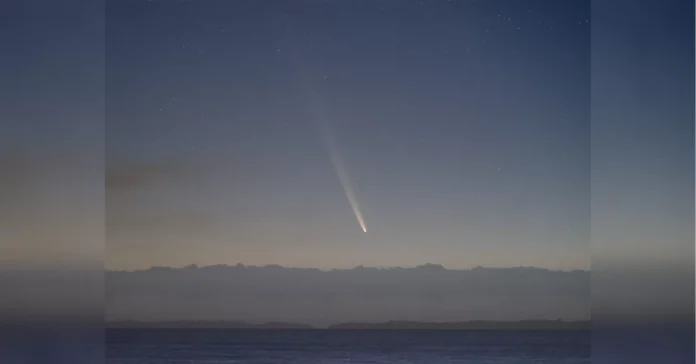In the middle of October, Earth will have a special visitor – a comet known as Halley’s Comet. This comet, named after astronomer Edmond Halley, is one of the most famous comets in history and is known for its regular appearances in our night sky.
Halley’s Comet is a periodic comet, meaning it orbits the Sun in a predictable pattern. It takes about 75-76 years for the comet to complete one orbit, which means it only visits Earth once every few decades. The last time Halley’s Comet was visible from Earth was in 1986, and it won’t be back until 2061. This makes the upcoming visit even more special, as it will be the only chance for many of us to see this amazing celestial event in our lifetime.
But that’s not the only exciting thing happening in the night sky this month. Towards the end of October, we will also be treated to the annual Orionid meteor shower. This meteor shower is caused by debris from Halley’s Comet, making it the perfect complement to the comet’s visit.
The Orionid meteor shower is named after the constellation Orion, as the meteors appear to radiate from this area of the sky. This year, the peak of the meteor shower is expected to occur on the night of October 21st and into the early morning hours of October 22nd. During this time, stargazers can expect to see around 20 meteors per hour, making it a great opportunity to witness a beautiful natural phenomenon.
So, what exactly is a meteor shower? It occurs when Earth passes through the debris left behind by a comet or asteroid. As these small particles enter Earth’s atmosphere, they burn up and create streaks of light in the sky, known as meteors. The Orionid meteor shower is particularly special because the debris comes from Halley’s Comet, which is one of the most well-known and studied comets in history.
The best way to view the Orionid meteor shower is to find a dark location away from city lights. Give your eyes some time to adjust to the darkness, and then look towards the constellation Orion. You may also be able to see some meteors in other parts of the sky, so keep an eye out for any sudden streaks of light.
While the Orionid meteor shower is an annual event, the appearance of Halley’s Comet is much rarer. This comet has been observed and recorded since ancient times, with the first recorded sighting dating back to 240 BC. Its regular appearances have been noted by many cultures throughout history, and it has been associated with various myths and legends.
One of the most famous sightings of Halley’s Comet was in 1066, when it appeared in the sky just before the Battle of Hastings. This event was seen as a bad omen by the English, who ultimately lost the battle to the Normans. However, the comet’s appearance was also recorded in the Bayeux Tapestry, a famous piece of medieval artwork that depicts the events leading up to the battle.
In more recent times, Halley’s Comet has been studied extensively by scientists. In 1986, a spacecraft was sent to intercept the comet and gather data about its composition and behavior. This mission provided valuable information about comets and their role in our solar system.
The upcoming visit of Halley’s Comet is a reminder of the vastness and beauty of our universe. It is a chance for us to witness a rare and spectacular event that has been observed by humans for centuries. And with the added bonus of the Orionid meteor shower, this month is shaping up to be an exciting time for stargazers and astronomy enthusiasts.
So mark your calendars for the middle and end of October, and don’t miss the chance to witness the majestic Halley’s Comet and the dazzling Orionid meteor shower. It’s a once-in-a-lifetime opportunity that you won’t want to miss. Happy stargazing!

